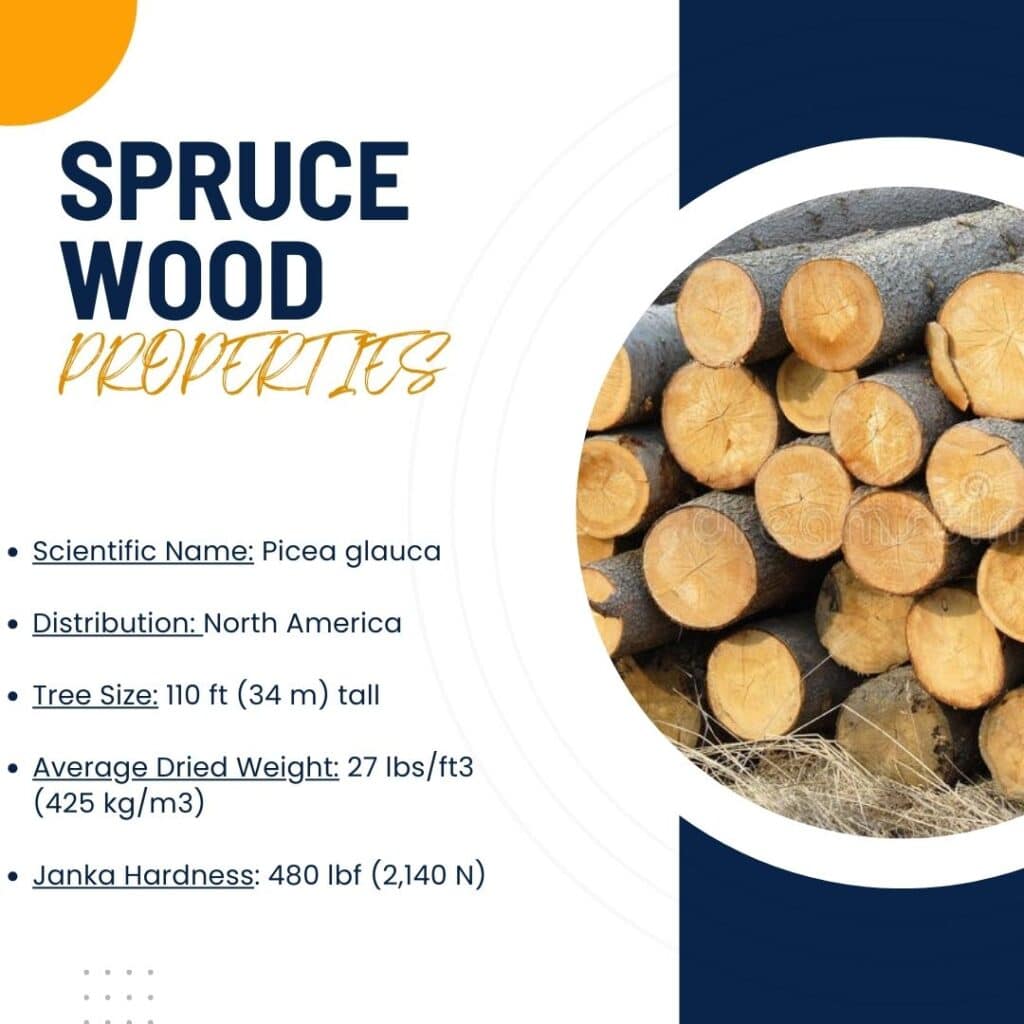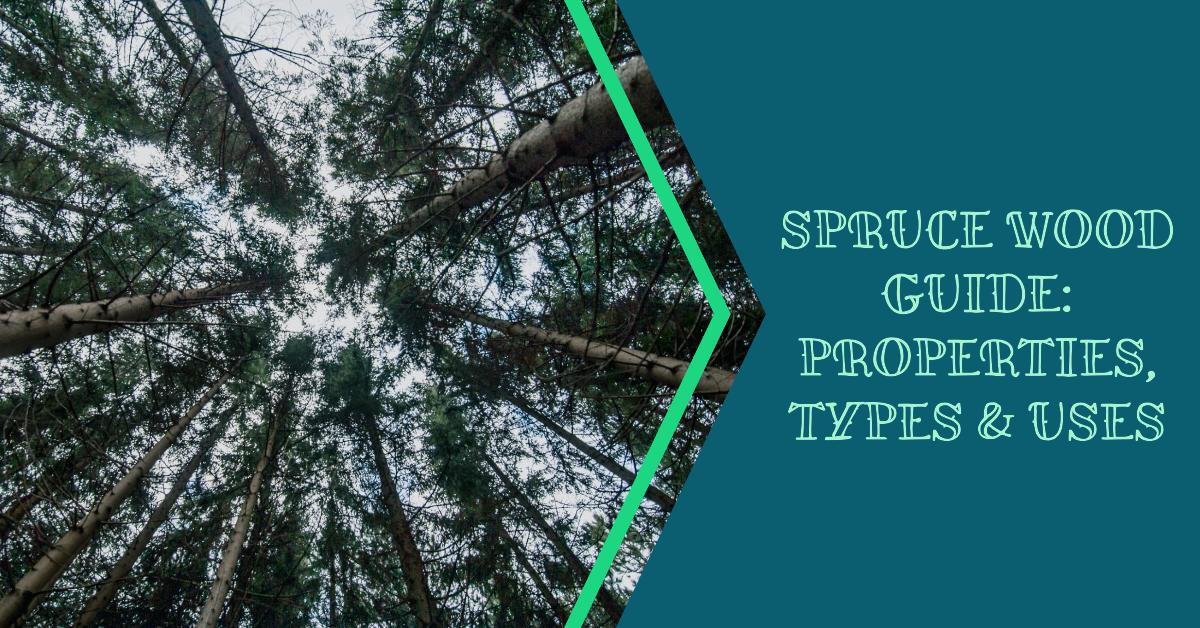Spruce wood is a versatile and valued material due to its exceptional properties, including natural strength, lightweight, and effortless workability. In this article, we will explore the distinctive characteristics, various types, and wide-ranging applications of spruce wood. From its distinct grain patterns to its remarkable durability, we will understand why spruce wood is a popular choice across different industries.
Common Properties of Spruce Wood

Popular Types of Spruce Wood & their Properties
1. Siberian Spruce
Siberian Spruce is one of the largest spruce wood species, capable of reaching heights of up to 40 meters (130 feet) in its native habitat of Siberia and parts of Asia. The tree typically features a tall, conical shape with dense foliage consisting of short, bluish-green needles. This wood is known for its resilience & adaptability boasting a fine texture and straight grain making it a favorite for various types of woodworking projects.
| Property | Description |
|---|---|
| Scientific Name | Picea obovata |
| Distribution | Northern Eurasia |
| Tree Size | Medium to large, reaching 30 to 35 meters (100 to 115 feet) tall |
| Average Dried Weight | Approximately 27 lbs/ft^3 (430 kg/m^3) |
| Janka Hardness | Approximately 510 lbf (2,270 N) |
| Strength | High |
| Workability | Fair |
| Grain | Straight |
| Color | Light to medium brown |
Common Uses: Framing, roofing, Decking, and fencing
2. White Spruce
White Spruce is the provincial tree of Manitoba, Canada, commonly used in reforestation efforts due to its adaptability to various soil and climate conditions. The trees are recognized by their slender, conical form and branches adorned with short, bluish-green needles. Revered for its light-colored wood and ease of workability, White Spruce is favored by artisans for its versatility in crafting everything from furniture to musical instruments.
| Property | Description |
|---|---|
| Scientific Name | Picea glauca |
| Distribution | North America |
| Tree Size | Medium, reaching 20 to 30 meters (65 to 100 feet) tall |
| Average Dried Weight | Approximately 26 lbs/ft^3 (415 kg/m^3) |
| Janka Hardness | Approximately 710 lbf (3,160 N) |
| Strength | Moderate |
| Workability | Excellent |
| Grain | Straight |
| Color | Pale |
Common Uses: Molding, trim, paneling, chairs, cabinets and Decorative Moldings
3. Sitka Spruce
Sitka Spruce is the largest species of spruce wood and is native to the Pacific Northwest of North America. Characterized by their lofty stature, Sitka trees consist of straight trunks, and drooping branches laden with short, glossy green needles. Because of its strength and flexibility, it is widely used in aircraft construction, ensuring both reliability & performance.
| Property | Description |
|---|---|
| Scientific Name | Picea sitchensis |
| Distribution | Western North America, Pacific Northwest |
| Tree Size | Large, reaching 45 to 55 meters (150 to 180 feet) tall |
| Average Dried Weight | Approximately 28 lbs/ft^3 (450 kg/m^3) |
| Janka Hardness | Approximately 510 lbf (2,270 N) |
| Strength | High |
| Workability | Easy |
| Grain | Straight |
| Color | Pale to light brown |
Common Uses: Guitars, pianos, violins, Aircraft framing, and sheathing
4. Serbian Spruce
Serbian Spruce is a rare and endangered species native to the Balkan Peninsula, particularly Serbia and Bosnia. It is valued for its ornamental beauty and is often cultivated in arboretums and botanical gardens. Serbian Spruce trees exhibit a graceful, pyramidal shape with dense, pendulous branches adorned with short, dark green needles.
| Property | Description |
|---|---|
| Scientific Name | Picea omorika |
| Distribution | Serbia, Bosnia and Herzegovina, Montenegro |
| Tree Size | Medium, reaching 25 to 30 meters (80 to 100 feet) tall |
| Average Dried Weight | Approximately 29 lbs/ft^3 (465 kg/m^3) |
| Janka Hardness | Approximately 510 lbf (2,270 N) |
| Strength | Moderate |
| Workability | Fair |
| Grain | Straight |
| Color | Light to medium brown |
Common Uses: Construction, Furniture Making & Pulpwood
5. Red Spruce
Red Spruce is a vital component of the iconic Appalachian forests of the eastern United States. This popular spruce type is distinguished by its tall, slender form and branches covered in short, bluish-green needles, often tinged with hints of red. It plays a crucial role in supporting diverse ecosystems and is also prized for its high-quality lumber used in construction.
| Property | Description |
|---|---|
| Scientific Name | Picea rubens |
| Distribution | Eastern North America |
| Tree Size | Medium to large, reaching 20 to 30 meters (65 to 100 feet) tall |
| Average Dried Weight | Approximately 26 lbs/ft^3 (415 kg/m^3) |
| Janka Hardness | Approximately 500 lbf (2,220 N) |
| Strength | Moderate |
| Workability | Fair |
| Grain | Straight |
| Color | Light to medium red-brown |
Common Uses: Musical Instruments, Boat Building & sheathing
6. Norway Spruce
Norway Spruce (Picea abies) is one of the most widely planted species globally and holds cultural significance in Europe, where it is often used as a Christmas tree. It is also valued for its resin, which has various industrial applications.
| Property | Description |
|---|---|
| Scientific Name | Picea abies |
| Distribution | Europe, Northern Asia, North America |
| Tree Size | Large, reaching 25 to 40 meters (80 to 130 feet) tall |
| Average Dried Weight | Approximately 28 lbs/ft^3 (450 kg/m^3) |
| Janka Hardness | Approximately 430 lbf (1,910 N) |
| Strength | Moderate to high |
| Workability | Fair |
| Grain | Straight |
| Color | Pale to light brown |
Common Uses: Framing, flooring, joinery, Fencing, and decking
7. Engelmann’s Spruce
This spruce variety features a tall, narrow crown with drooping branches adorned with short, bluish-green needles. Noted for its resilience to harsh climates, Engelmann’s Spruce thrives in mountainous regions of North America, where it serves as a vital habitat for numerous wildlife species, including birds and mammals.
| Property | Description |
|---|---|
| Scientific Name | Picea engelmannii |
| Distribution | Western North America |
| Tree Size | Large, reaching 25 to 40 meters (80 to 130 feet) tall |
| Average Dried Weight | Approximately 28 lbs/ft^3 (450 kg/m^3) |
| Janka Hardness | Approximately 380 lbf (1,690 N) |
| Strength | Moderate |
| Workability | Fair |
| Grain | Straight |
| Color | Light to medium brown |
Common Uses: Framing, millwork, Doors, windows, and Interior wall paneling
8. Dwarf Alberta Spruce
Dwarf Alberta Spruce is a popular ornamental shrub cultivated for its compact size and symmetrical shape, with branches covered in tiny, light green needles making it a favorite choice for landscaping and gardens.
| Property | Description |
|---|---|
| Scientific Name | Picea glauca ‘Conica’ |
| Distribution | Cultivated worldwide as an ornamental plant |
| Tree Size | Small, reaching 1 to 3 meters (3 to 10 feet) tall |
| Average Dried Weight | Approximately 22 lbs/ft^3 (350 kg/m^3) |
| Janka Hardness | Approximately 390 lbf (1,730 N) |
| Strength | Low |
| Workability | Easy |
| Grain | Fine |
| Color | Dark green |
Common Uses: Small gardens, rock gardens, Pots, and planters
9. Colorado Blue Spruce
Colorado Blue Spruce, as the name suggests is the state tree of Colorado and is renowned for its striking blue foliage. This spruce wood stands out with its striking blue-green needles arranged in dense clusters on branches forming a pyramidal shape. It is often planted as an ornamental tree in parks, gardens, and urban landscapes.
| Property | Description |
|---|---|
| Scientific Name | Picea pungens |
| Distribution | Western United States |
| Tree Size | Medium to large, reaching 15 to 30 meters (50 to 100 feet) tall |
| Average Dried Weight | Approximately 30 lbs/ft^3 (480 kg/m^3) |
| Janka Hardness | Approximately 510 lbf (2,270 N) |
| Strength | Moderate |
| Workability | Fair |
| Grain | Fine |
| Color | Blue-green |
Common Uses: Hedges, specimen trees, holiday decorations and Windbreaks
10. Caucasian Spruce
It is native to the Caucasus Mountains and is valued for its timber, often used in construction and furniture-making. Caucasian Spruce trees are majestic with a broad, conical crown and branches adorned with long, slender needles of dark green color. Revered for its dense foliage, the Caucasian Spruce is mainly used for providing shade and shelter in forested landscapes because of its ability to adapt to diverse climatic conditions.
| Property | Description |
|---|---|
| Scientific Name | Picea orientalis |
| Distribution | Caucasus Mountains, Eastern Europe |
| Tree Size | Medium to large, reaching 25 to 30 meters (80 to 100 feet) tall |
| Average Dried Weight | Approximately 24 lbs/ft^3 (385 kg/m^3) |
| Janka Hardness | Approximately 370 lbf (1,650 N) |
| Strength | Moderate |
| Workability | Fair |
| Grain | Straight |
| Color | Pale to light brown |
Common Uses: Framing, flooring, Cabinets and chests
11. Brewer Spruce
Known for its unique appearance Brewer Spruce is considered a rare and endangered species native to the mountains of northern California and southern Oregon. The trees are large and imposing, with a straight trunk and branches holding short, blue-green needles making it a preferred material for structural applications.
| Property | Description |
|---|---|
| Scientific Name | Picea breweriana |
| Distribution | Western United States |
| Tree Size | Medium to large, reaching 30 to 40 meters (100 to 130 feet) tall |
| Average Dried Weight | Approximately 28 lbs/ft^3 (450 kg/m^3) |
| Janka Hardness | Approximately 390 lbf (1,730 N) |
| Strength | Moderate |
| Workability | Fair |
| Grain | Straight |
| Color | Light to medium brown |
Common Uses: Framing, Tables, chairs, and Pulpwood
12. Black Spruce
Black Spruce is a well-known spruce tree, especially in Canada’s cold areas. It’s popular because it’s tough and can handle harsh weather. The trees look tall and skinny with short, dark green needles that smell nice. People like its dark wood and is mostly favored for its aromatic properties, often used for the production of essential oils and fragrances.
| Property | Description |
|---|---|
| Scientific Name | Picea mariana |
| Distribution | Northern North America |
| Tree Size | Medium, reaching 15 to 25 meters (50 to 80 feet) tall |
| Average Dried Weight | Approximately 26 lbs/ft^3 (415 kg/m^3) |
| Janka Hardness | Approximately 450 lbf (2,000 N) |
| Strength | Moderate |
| Workability | Fair |
| Grain | Straight |
| Color | Dark brown to black |
Common Uses: Paper Production, Construction, Crates and Pallets
13. Bird’s Nest Spruce
Bird’s Nest Spruce is a special spruce tree known for its unique shape like a bird’s nest. It’s small and compact, making it great for decorating rock gardens and small yards. Its interesting appearance adds a nice touch to gardens, catching people’s attention with its bird’s nest-like form.
| Property | Description |
|---|---|
| Scientific Name | Picea abies ‘Nidiformis’ |
| Distribution | Cultivated as an ornamental plant worldwide |
| Tree Size | Small, reaching 1 to 2 meters (3 to 6 feet) tall |
| Average Dried Weight | Approximately 26 lbs/ft^3 (415 kg/m^3) |
| Janka Hardness | Approximately 390 lbf (1,730 N) |
| Strength | Low |
| Workability | Easy |
| Grain | Fine |
| Color | Dark green |
Common Uses: Ornamental Landscaping, Garden Accents, and Ground Cover

